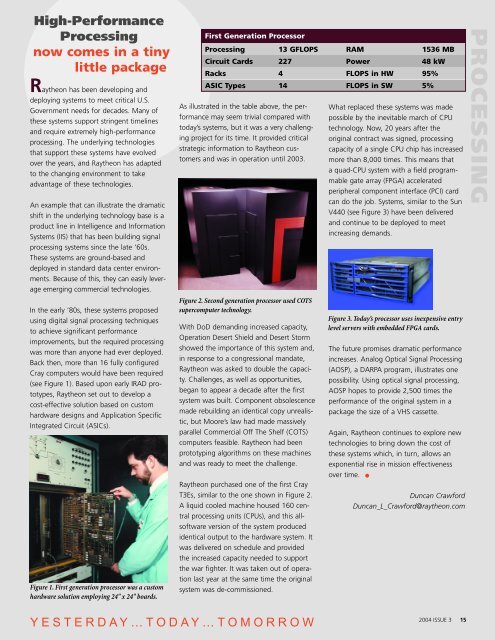2004 Issue 3 - Raytheon
2004 Issue 3 - Raytheon
2004 Issue 3 - Raytheon
Create successful ePaper yourself
Turn your PDF publications into a flip-book with our unique Google optimized e-Paper software.
High-Performance<br />
Processing<br />
now comes in a tiny<br />
little package<br />
<strong>Raytheon</strong> has been developing and<br />
deploying systems to meet critical U.S.<br />
Government needs for decades. Many of<br />
these systems support stringent timelines<br />
and require extremely high-performance<br />
processing. The underlying technologies<br />
that support these systems have evolved<br />
over the years, and <strong>Raytheon</strong> has adapted<br />
to the changing environment to take<br />
advantage of these technologies.<br />
An example that can illustrate the dramatic<br />
shift in the underlying technology base is a<br />
product line in Intelligence and Information<br />
Systems (IIS) that has been building signal<br />
processing systems since the late ‘60s.<br />
These systems are ground-based and<br />
deployed in standard data center environments.<br />
Because of this, they can easily leverage<br />
emerging commercial technologies.<br />
In the early ‘80s, these systems proposed<br />
using digital signal processing techniques<br />
to achieve significant performance<br />
improvements, but the required processing<br />
was more than anyone had ever deployed.<br />
Back then, more than 16 fully configured<br />
Cray computers would have been required<br />
(see Figure 1). Based upon early IRAD prototypes,<br />
<strong>Raytheon</strong> set out to develop a<br />
cost-effective solution based on custom<br />
hardware designs and Application Specific<br />
Integrated Circuit (ASICs).<br />
Figure 1. First generation processor was a custom<br />
hardware solution employing 24" x 24" boards.<br />
First Generation Processor<br />
Processing 13 GFLOPS RAM 1536 MB<br />
Circuit Cards 227 Power 48 kW<br />
Racks 4 FLOPS in HW 95%<br />
ASIC Types 14 FLOPS in SW 5%<br />
As illustrated in the table above, the performance<br />
may seem trivial compared with<br />
today’s systems, but it was a very challenging<br />
project for its time. It provided critical<br />
strategic information to <strong>Raytheon</strong> customers<br />
and was in operation until 2003.<br />
Figure 2. Second generation processor used COTS<br />
supercomputer technology.<br />
With DoD demanding increased capacity,<br />
Operation Desert Shield and Desert Storm<br />
showed the importance of this system and,<br />
in response to a congressional mandate,<br />
<strong>Raytheon</strong> was asked to double the capacity.<br />
Challenges, as well as opportunities,<br />
began to appear a decade after the first<br />
system was built. Component obsolescence<br />
made rebuilding an identical copy unrealistic,<br />
but Moore’s law had made massively<br />
parallel Commercial Off The Shelf (COTS)<br />
computers feasible. <strong>Raytheon</strong> had been<br />
prototyping algorithms on these machines<br />
and was ready to meet the challenge.<br />
<strong>Raytheon</strong> purchased one of the first Cray<br />
T3Es, similar to the one shown in Figure 2.<br />
A liquid cooled machine housed 160 central<br />
processing units (CPUs), and this allsoftware<br />
version of the system produced<br />
identical output to the hardware system. It<br />
was delivered on schedule and provided<br />
the increased capacity needed to support<br />
the war fighter. It was taken out of operation<br />
last year at the same time the original<br />
system was de-commissioned.<br />
YESTERDAY…TODAY…TOMORROW<br />
What replaced these systems was made<br />
possible by the inevitable march of CPU<br />
technology. Now, 20 years after the<br />
original contract was signed, processing<br />
capacity of a single CPU chip has increased<br />
more than 8,000 times. This means that<br />
a quad-CPU system with a field programmable<br />
gate array (FPGA) accelerated<br />
peripheral component interface (PCI) card<br />
can do the job. Systems, similar to the Sun<br />
V440 (see Figure 3) have been delivered<br />
and continue to be deployed to meet<br />
increasing demands.<br />
Figure 3. Today’s processor uses inexpensive entry<br />
level servers with embedded FPGA cards.<br />
The future promises dramatic performance<br />
increases. Analog Optical Signal Processing<br />
(AOSP), a DARPA program, illustrates one<br />
possibility. Using optical signal processing,<br />
AOSP hopes to provide 2,500 times the<br />
performance of the original system in a<br />
package the size of a VHS cassette.<br />
Again, <strong>Raytheon</strong> continues to explore new<br />
technologies to bring down the cost of<br />
these systems which, in turn, allows an<br />
exponential rise in mission effectiveness<br />
over time. •<br />
Duncan Crawford<br />
Duncan_L_Crawford@raytheon.com<br />
<strong>2004</strong> ISSUE 3 15<br />
PROCESSING

















